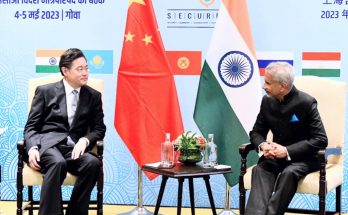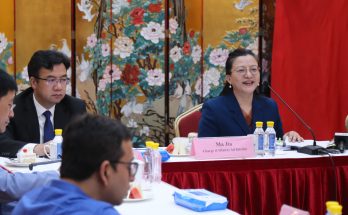 Recently, Jack Ma, founder of Alibaba, mentioned during his India visit that Alibaba has had a 15-year business-to-business relationship with Indian vendors. 400,000 Chinese are buying tea and spices etc. from India through Alibaba, and around 1.3 million Indian vendors are doing booming business on Alibaba platforms. Alibaba’s successful listing at the New York Stock Exchange is a glowing testimony of the intertwined interests of and win-win cooperation between China, India and the US.
Recently, Jack Ma, founder of Alibaba, mentioned during his India visit that Alibaba has had a 15-year business-to-business relationship with Indian vendors. 400,000 Chinese are buying tea and spices etc. from India through Alibaba, and around 1.3 million Indian vendors are doing booming business on Alibaba platforms. Alibaba’s successful listing at the New York Stock Exchange is a glowing testimony of the intertwined interests of and win-win cooperation between China, India and the US.
US-China-India trilateral
China and India are the world’s biggest developing countries and the US is the world’s biggest developed country. The combined GDP and population of these three countries form almost 40% of the global share. And they share the common mission of promoting global peace and development. The peaceful coexistence and win-win cooperation between China, India and the US will not only benefit the 2.8 billion people of our three countries but will also have far-reaching impact on the world’s development. The closer interactions between the leaders of our three countries this year have attracted widespread global attention. Here I would like to focus on three visits to share my observations and views on the China-India-US trilateral relationship with all of you:
China-India relations
 In September, President Xi Jinping carried out his immensely successful historical visit to India, taking the China-India relations to a new level. President Xi’s first stop was in Gujarat where Prime Minister Narendra Modi himself accompanied him to Sabarmati Ashram where they jointly operated the spinning wheel and had frank discussions while taking a walk at the Sabarmati riverfront. The idea that “China and India are two bodies with one spirit” is widely known in our two countries. This long visit yielded rich dividends and had profound impact. Both countries signed fifteen cooperation agreements and arrived at a common understanding on a series of issues. It was emphasised that China and India should become closer partners for development, cooperative partners for growth and global partners for strategic coordination and jointly pursue their dreams of national renewal. At present, both China and India are at the similar stage of development, have mutually compatible ideas of development, clear complementary advantages and huge potential for cooperation. China is willing to jointly work with India, together guide the direction of cooperation, seize new historical opportunities, let good-neighborly relationship and mutually beneficial cooperation become the main theme of the bilateral relations, comprehensively raise the level of pragmatic cooperation, strengthen the communication and cooperation on international and regional affairs, thus taking the China-India relations to new heights. We are full of confidence on the future development of the China-India relations and are eagerly looking forward to Prime Minister Narendra Modi’s visit to China next year.
In September, President Xi Jinping carried out his immensely successful historical visit to India, taking the China-India relations to a new level. President Xi’s first stop was in Gujarat where Prime Minister Narendra Modi himself accompanied him to Sabarmati Ashram where they jointly operated the spinning wheel and had frank discussions while taking a walk at the Sabarmati riverfront. The idea that “China and India are two bodies with one spirit” is widely known in our two countries. This long visit yielded rich dividends and had profound impact. Both countries signed fifteen cooperation agreements and arrived at a common understanding on a series of issues. It was emphasised that China and India should become closer partners for development, cooperative partners for growth and global partners for strategic coordination and jointly pursue their dreams of national renewal. At present, both China and India are at the similar stage of development, have mutually compatible ideas of development, clear complementary advantages and huge potential for cooperation. China is willing to jointly work with India, together guide the direction of cooperation, seize new historical opportunities, let good-neighborly relationship and mutually beneficial cooperation become the main theme of the bilateral relations, comprehensively raise the level of pragmatic cooperation, strengthen the communication and cooperation on international and regional affairs, thus taking the China-India relations to new heights. We are full of confidence on the future development of the China-India relations and are eagerly looking forward to Prime Minister Narendra Modi’s visit to China next year.
China-US relations
I n November this year, China successfully held the 22nd APEC Economic Leaders’ Meeting. US President Barack Obama participated in the APEC meeting and successfully carried out his second state visit to China. The Chinese and American leaders had candid and intensive exchange of views over rounds of talks, walks and tea gatherings. Both sides reiterated their goal of jointly constructing a new model of major-country relations, arrived at a common understanding on more than twenty issues, including the “Sino-US Joint Declaration on Climate Change”, and agreement on reciprocal 10-year visa policy for tourists and businessmen. In the 35 years since the establishment of diplomatic relations between China and the US, both countries have established more than ninety intergovernmental dialogue mechanisms. Bilateral trade volume has increased more than 200 times, exceeding $520 billion in 2013, two-way investment stock exceeds 100 billion USD, 41 provinces/states and 202 cities from the two countries have established sister relationships, and personnel exchanges between the two countries surpasses four million person times every year. Sino-U.S. cooperation not only benefits the people of our two countries, but also promotes world peace, stability and development.
n November this year, China successfully held the 22nd APEC Economic Leaders’ Meeting. US President Barack Obama participated in the APEC meeting and successfully carried out his second state visit to China. The Chinese and American leaders had candid and intensive exchange of views over rounds of talks, walks and tea gatherings. Both sides reiterated their goal of jointly constructing a new model of major-country relations, arrived at a common understanding on more than twenty issues, including the “Sino-US Joint Declaration on Climate Change”, and agreement on reciprocal 10-year visa policy for tourists and businessmen. In the 35 years since the establishment of diplomatic relations between China and the US, both countries have established more than ninety intergovernmental dialogue mechanisms. Bilateral trade volume has increased more than 200 times, exceeding $520 billion in 2013, two-way investment stock exceeds 100 billion USD, 41 provinces/states and 202 cities from the two countries have established sister relationships, and personnel exchanges between the two countries surpasses four million person times every year. Sino-U.S. cooperation not only benefits the people of our two countries, but also promotes world peace, stability and development.
India-US relations
 This year Prime Minister Narendra Modi carried out his US visit successfully and in the beginning of the next year President Barack Obama will visit India. China is pleased to see even bigger development in the India-US relations and hope that the development in the India-US relations will help in bringing regional stability and prosperity.
This year Prime Minister Narendra Modi carried out his US visit successfully and in the beginning of the next year President Barack Obama will visit India. China is pleased to see even bigger development in the India-US relations and hope that the development in the India-US relations will help in bringing regional stability and prosperity.
New Model of Major-country relations
In today’s world, the interdependence between various countries is increasing day-by-day; it is no longer a “zero-sum relationship” between the major-countries; the new situation calls for a new interactive model between various countries. President Xi has mentioned about promoting the construction of a new model of major-country relationship with the spirit of “accumulating droplets to form a pool and heaping earth to put up a mountain”. President Xi brilliantly summed up the new model of major-country relationship in three sentences: “No conflict or confrontation” is the prerequisite for the new model. “Mutual respect” is the basic principle for the new model. “Win-win cooperation” is the only way to turn this vision into a reality. China is promoting the construction of a new model of major-country relationship with the US right now. Similarly, utilising the opportunity to forge an even closer partnership for development with India, China is willing to establish a new model of bilateral relationship with India, driven towards developing cooperation and controlling differences. I believe that the development of bilateral relations between China, India and the US should not be directed against any third party, and must conform to the spirit of “no conflict or confrontation”,“mutual respect”,and “win-win cooperation”.
Intertwined Interests
Social systems in China, the US and India are different; the historical and cultural backgrounds are also different. However, the interests of the three countries are mutually intertwined, and hence “mutual respect” is especially important in our relationships. Every side should respect each other’s core interests and concerns, must respect each other’s choice of the path of development, must recognise that common interests are far greater than differences, and must continue to enhance understanding, broaden common ground and deepen mutual trust through dialogue and consultation. Only then we would able to seek common ground and further expand it while narrowing down differences, and would able to take the road of peaceful cooperation never taken before. China, India and the US have widespread need and immense potential for cooperation in the bilateral and multilateral domains. From interconnecting the world to facilitating trade, from global warming to energy security, from fighting ebola epidemic to defeating terrorism, every single area requires joint participation, cooperation and contribution from these three countries. These are the expectations of the international community from our three countries and also the very essence of the development of the trilateral relations between China, India and the U.S.
Common Destiny
 In the Central Conference on Work Relating to Foreign Affairs held recently, President Xi Jinping emphasised on forging China’s neighbourhood areas into a community of common destiny, and boost mutually-beneficial cooperation and connectivity with our neighbours. He also stressed on building a sound and stable framework of major-country relations, and expand cooperation with other major developing countries. He underscored the need to work hard to expand the converging interests of various parties, and promote win-win outcome through results-oriented cooperation. In the year 2013 the trade volume between China and various neighbouring countries in East Asia and South Asia exceeded $1.14 trillion; around 70% of the Chinese overseas investment goes towards countries and regions in Asia. China has already become the biggest trading partner, the biggest export market and an important overseas investor of a large number of neighbouring countries. Since 2013, Chinese leaders have made intensive visits to neighbouring countries, and proposed a series of cooperation initiatives like building a “Silk Road economic belt” and a “21st Century Maritime Silk Road”, establishing Asian Infrastructure Development Bank (AIIB), contributing $40 billion for “Silk Road Fund”, and building the BCIM economic corridor etc. which have received active response from more than 50 countries. China is willing to collaborate closely with the neighbouring countries, taking the realisation of these initiatives as an opportunity, bring even larger number of “Chinese opportunities” and development dividends for the neighbourhood region, and infuse powerful energy in the economic development to benefit the people of various neighbouring countries.
In the Central Conference on Work Relating to Foreign Affairs held recently, President Xi Jinping emphasised on forging China’s neighbourhood areas into a community of common destiny, and boost mutually-beneficial cooperation and connectivity with our neighbours. He also stressed on building a sound and stable framework of major-country relations, and expand cooperation with other major developing countries. He underscored the need to work hard to expand the converging interests of various parties, and promote win-win outcome through results-oriented cooperation. In the year 2013 the trade volume between China and various neighbouring countries in East Asia and South Asia exceeded $1.14 trillion; around 70% of the Chinese overseas investment goes towards countries and regions in Asia. China has already become the biggest trading partner, the biggest export market and an important overseas investor of a large number of neighbouring countries. Since 2013, Chinese leaders have made intensive visits to neighbouring countries, and proposed a series of cooperation initiatives like building a “Silk Road economic belt” and a “21st Century Maritime Silk Road”, establishing Asian Infrastructure Development Bank (AIIB), contributing $40 billion for “Silk Road Fund”, and building the BCIM economic corridor etc. which have received active response from more than 50 countries. China is willing to collaborate closely with the neighbouring countries, taking the realisation of these initiatives as an opportunity, bring even larger number of “Chinese opportunities” and development dividends for the neighbourhood region, and infuse powerful energy in the economic development to benefit the people of various neighbouring countries.
The Road Ahead: In One Voice
As President Xi Jinping has said on relations between Beijing and Washington, “the vast Pacific Ocean has ample space to accommodate our two great nations.” And on the relations between Beijing and New Delhi, he has said: “If we speak with one voice, the whole world will listen.” As long as we collectively show enough foresight, courage and open-mindedness, China, India and the US can express similar understanding in three different languages of Chinese, Hindi and English, and can realise the trans-Pacific Ocean and trans-Indian Ocean cooperation in the 21st century, thus bringing the people of our three countries and even the entire world even greater prosperity. We can become the “ballast stone,” ensuring the peace and stability of the world, and the boosters of global economic growth.
 (This is the edited version of the speech delivered by China’s ambassador to India Le Yucheng at a conference themed, “India, the US and China in the 21st Century” on December 13, 2014. The Chinese envoy’s speech was entitled “Constructing a new model of major- country relations of win-win cooperation.”)
(This is the edited version of the speech delivered by China’s ambassador to India Le Yucheng at a conference themed, “India, the US and China in the 21st Century” on December 13, 2014. The Chinese envoy’s speech was entitled “Constructing a new model of major- country relations of win-win cooperation.”)
Author Profile
- India Writes Network (www.indiawrites.org) is an emerging think tank and a media-publishing company focused on international affairs & the India Story. Centre for Global India Insights is the research arm of India Writes Network. To subscribe to India and the World, write to editor@indiawrites.org. A venture of TGII Media Private Limited, a leading media, publishing and consultancy company, IWN has carved a niche for balanced and exhaustive reporting and analysis of international affairs. Eminent personalities, politicians, diplomats, authors, strategy gurus and news-makers have contributed to India Writes Network, as also “India and the World,” a magazine focused on global affairs.
Latest entries
 DiplomacyApril 10, 2024Diplomat-author Lakshmi Puri pitches for women power at LSR
DiplomacyApril 10, 2024Diplomat-author Lakshmi Puri pitches for women power at LSR India and the WorldApril 6, 2024UN envoy pitches to take India’s solutions to the world stage
India and the WorldApril 6, 2024UN envoy pitches to take India’s solutions to the world stage CultureApril 5, 2024Youth in Diplomacy: Making it Matter with LSR Model UN 2024
CultureApril 5, 2024Youth in Diplomacy: Making it Matter with LSR Model UN 2024 India and the WorldMarch 28, 2024India to China: Normalization of troops deployment imperative for restoring ties
India and the WorldMarch 28, 2024India to China: Normalization of troops deployment imperative for restoring ties







